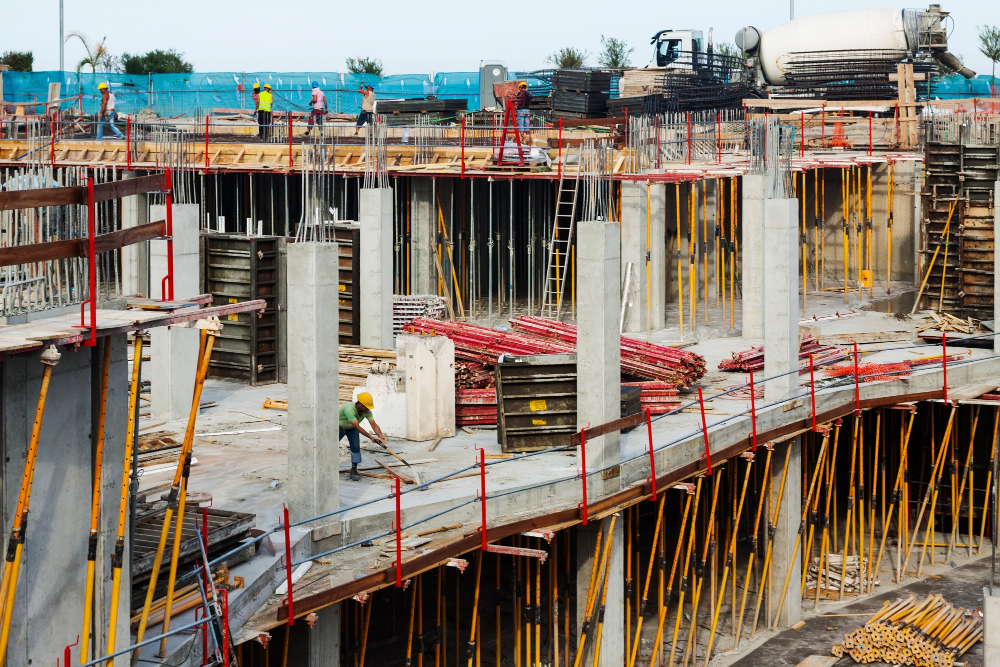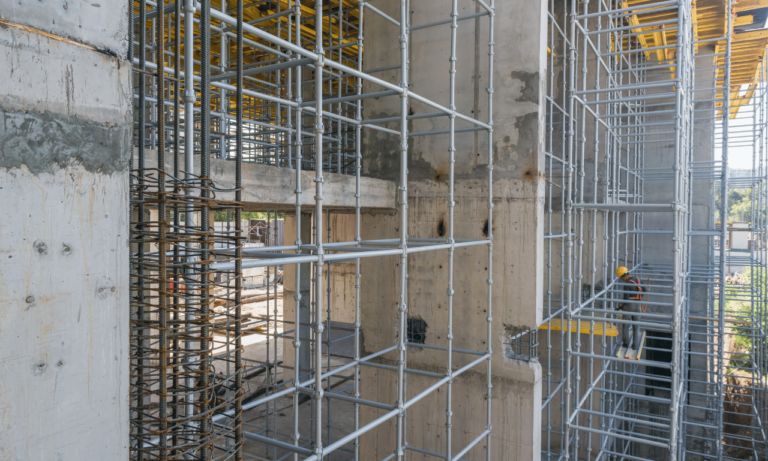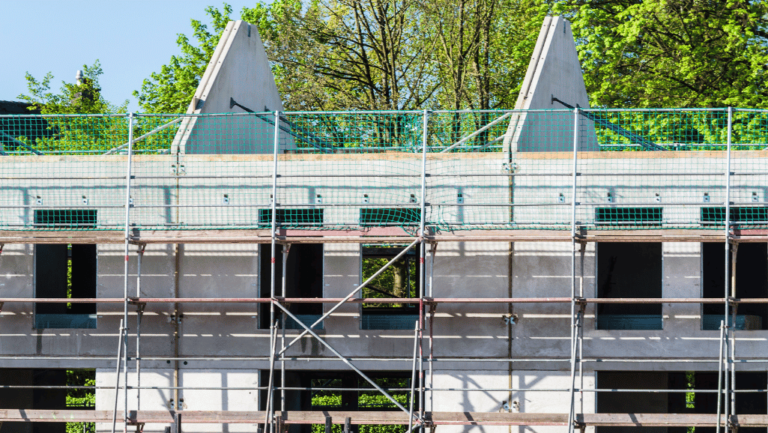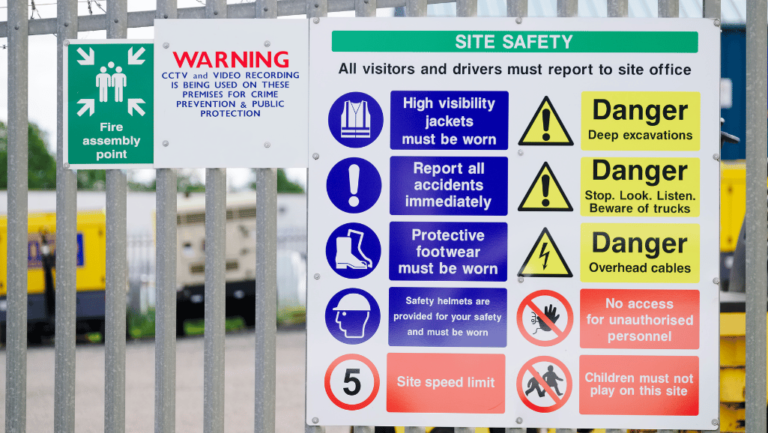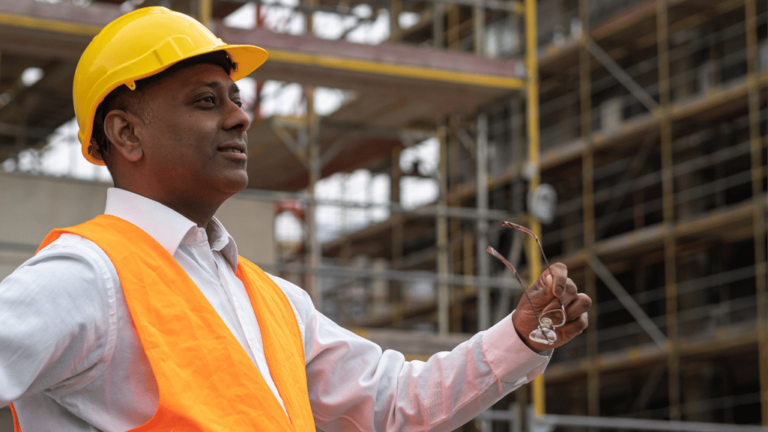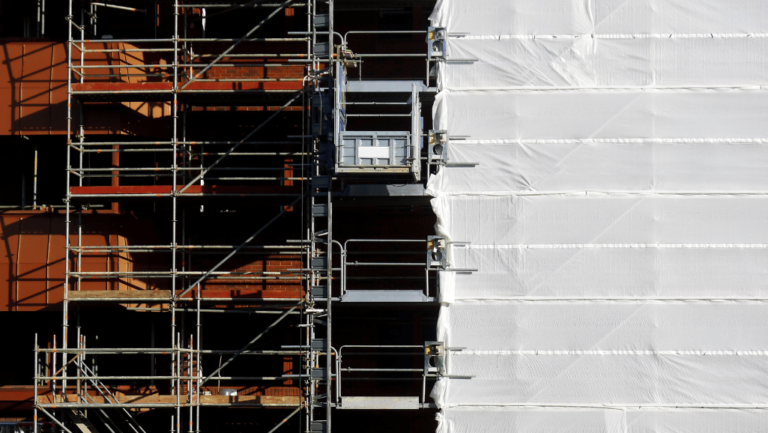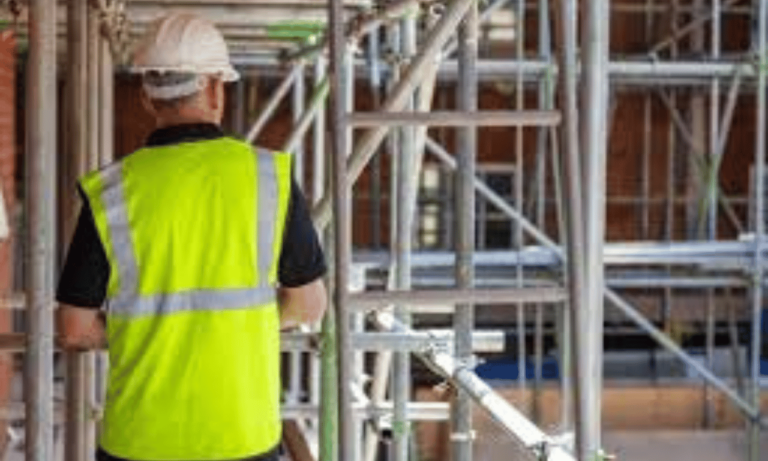Phone:
(+65)8319-0742
Guardrail systems play a crucial role in ensuring worker protection and compliance with OSHA regulations on construction sites. These systems act as a barrier to prevent falls and accidents, safeguarding the well-being of construction workers and minimizing the risk of injuries and fatalities.
OSHA-compliant guardrails are designed with specific guidelines and standards to provide effective protection. Their installation and proper adherence to safety protocols are essential to maintain a secure working environment in construction.
In this article, we will explore the importance of guardrail systems in construction, the different types available, and the materials used in their design. We will also discuss the criteria to consider when choosing the right guardrail supplier and highlight the various benefits that these systems bring to construction projects beyond safety and compliance.
Key Takeaways:
- Guardrail systems are a vital safety measure to protect construction workers from falls and accidents.
- OSHA compliance is crucial for guardrail installation to ensure proper worker protection.
- There are different types of guardrail systems, including highway guardrails and industrial guardrails.
- Steel guardrail systems are widely used due to their durability and strength.
- Choosing the right guardrail supplier is vital for obtaining reliable and high-quality systems.
Importance of Guardrail Systems
Guardrail systems play a crucial role in ensuring the safety and protection of workers on construction sites. These safety guardrails act as protective barriers, effectively reducing the risk of falls, accidents, injuries, and even fatalities. By implementing proper guardrail systems, construction companies prioritize the well-being of their employees while maintaining compliance with safety regulations.
Protective guardrails act as a physical barrier, preventing individuals from accessing hazardous areas or falling from elevated platforms. They create a secure working environment, enabling workers to carry out their tasks with confidence and peace of mind. Whether it’s on rooftops, scaffolds, stairways, or other elevated surfaces, safety guardrails provide a much-needed layer of protection against potential hazards.
The use of guardrail systems is not just about meeting safety requirements; it demonstrates a commitment to worker well-being. Construction accidents can result in severe injuries or even loss of life. By installing proper safety guardrails, companies can significantly minimize these risks, safeguarding their workforce and avoiding costly legal consequences.
Furthermore, safety guardrails promote a culture of safety on construction sites. When workers see that their employers prioritize their safety by investing in protective guardrails, they are more likely to follow safety protocols and remain vigilant. This collective commitment to safety not only reduces the number of accidents but also enhances overall productivity and efficiency.
It is essential to recognize that using guardrail systems goes beyond meeting regulatory requirements. Protective guardrails offer peace of mind to workers and their families, knowing that they are entering a safe work environment. Moreover, they contribute to the positive reputation of construction companies that prioritize worker safety and well-being.
Next, we will explore the different types of guardrail systems available, catering to diverse construction needs and environments. This comprehensive overview will provide insight into selecting the most suitable guardrail system for specific construction projects and ensure maximum safety and protection.
Types of Guardrail Systems
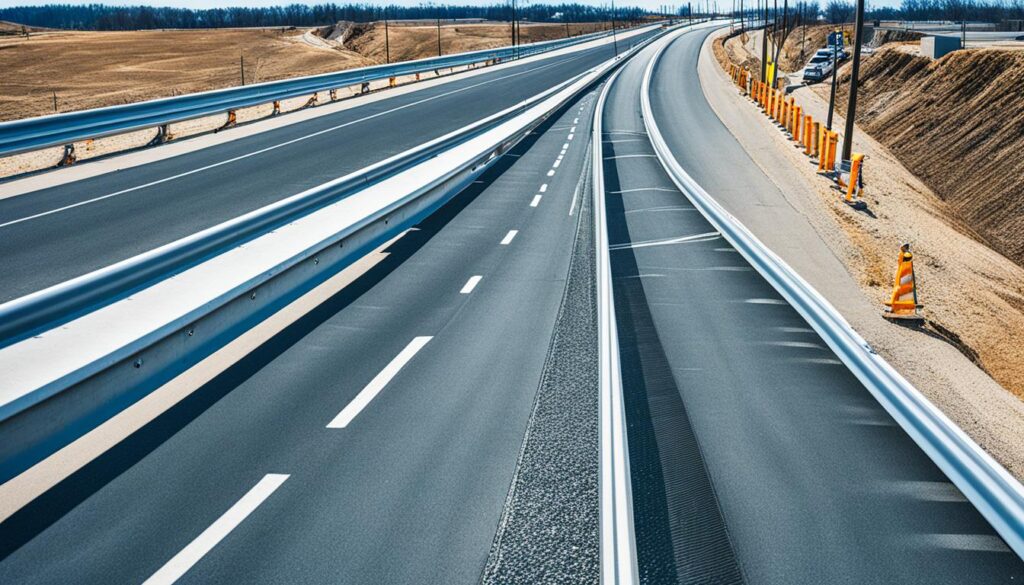
When it comes to ensuring safety and protection in different environments, guardrail systems play a crucial role. There are various types of guardrail systems available, each designed to address specific needs and enhance safety measures. In this section, we will explore two prominent types of guardrail systems: highway guardrails and industrial guardrail systems.
Highway Guardrails
Highway guardrails are specifically designed to safeguard drivers and passengers on roads and highways. These systems provide a protective barrier between vehicles and potential hazards, such as steep slopes, roadside obstacles, or other vehicles. Highway guardrails are crucial in preventing accidents and minimizing the impact of collisions, reducing the severity of injuries.
These guardrail systems are typically made of durable materials, such as steel, designed to withstand the force of vehicle impacts. They are strategically positioned along highways, ensuring maximum coverage and protection. Highway guardrails are engineered to redirect or contain vehicles, minimizing the chances of vehicles veering off the road or crossing into opposing traffic lanes.
Industrial Guardrail Systems
Industrial settings pose unique safety challenges due to the presence of heavy machinery, equipment, and hazardous materials. Industrial guardrail systems are specifically designed to protect workers, equipment, and property in these environments. They provide a sturdy barrier that prevents accidental falls and collisions, ensuring a safe working environment.
Industrial guardrail systems are often used in factories, warehouses, construction sites, and other industrial facilities. They act as a protective shield, preventing workers from falling off elevated platforms or getting too close to dangerous machinery. These guardrails are typically made of robust materials, such as steel, to withstand the harsh conditions and potential impacts in industrial environments.
Furthermore, industrial guardrail systems can be customized to suit specific requirements, ensuring optimal safety measures tailored to the unique needs of each industrial setting. By implementing these guardrail systems, organizations can significantly reduce the risk of accidents, injuries, and property damage, promoting a safer work environment and boosting overall productivity.
In summary, guardrail systems, such as highway guardrails and industrial guardrail systems, play a critical role in ensuring safety and protection in various environments. Whether it’s safeguarding drivers and passengers on highways or protecting workers and equipment in industrial settings, these guardrail systems are essential components in creating secure spaces.
OSHA Compliance and Guardrail Installation
When it comes to ensuring safety on construction sites, guardrail installation plays a critical role. Not only does it protect workers from falls and accidents, but it also ensures compliance with OSHA regulations. OSHA compliant guardrails are designed to provide a secure barrier, preventing potential hazards and minimizing risks.
OSHA has set specific guidelines for guardrail installation to ensure the highest level of worker protection. These guidelines outline the proper techniques and safety standards that must be followed during the installation process. Adhering to these guidelines is crucial to create a safe working environment that meets OSHA requirements.
Importance of OSHA Compliance
- OSHA compliance demonstrates a commitment to worker safety and well-being. By following the guidelines, employers and contractors prioritize the welfare of their employees, reducing the likelihood of accidents and injuries.
- Adhering to OSHA regulations helps companies avoid costly fines and penalties. Non-compliance can result in significant financial setbacks, as well as damage to the business’s reputation.
- Complying with OSHA standards minimizes liability for employers and contractors. By implementing OSHA compliant guardrail systems, organizations can mitigate the risk of lawsuits and legal issues associated with workplace accidents.
The Importance of Proper Guardrail Installation
Proper guardrail installation is essential to ensure the effectiveness of the system in preventing falls and accidents. It involves meticulous attention to detail and adherence to safety guidelines. Key considerations during the installation process include:
- Installing guardrails at appropriate heights and locations to create a secure barrier around elevated work areas.
- Using high-quality materials that meet OSHA standards for strength and durability.
- Ensuring that guardrails are properly anchored and securely fastened to withstand impact forces.
- Regularly inspecting guardrails for signs of wear, damage, or instability, and promptly addressing any issues.
Design and Materials of Guardrail Systems
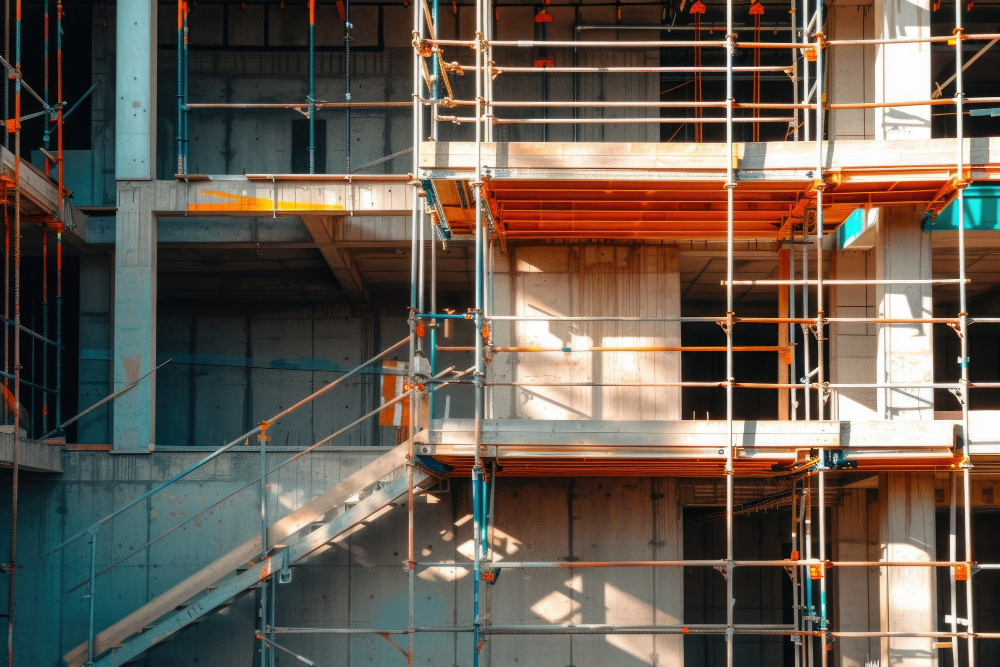
When it comes to guardrail systems, the design and materials used play a crucial role in ensuring effective protection and long-lasting durability. One of the most popular choices in the industry is steel guardrail systems, known for their exceptional strength and reliability.
Steel guardrail systems offer numerous advantages that make them an ideal choice for various construction applications. Their robust construction provides a sturdy barrier against potential hazards, offering enhanced safety for workers and pedestrians alike. The inherent strength of steel ensures that the guardrail can withstand impacts and effectively absorb energy, minimizing the risk of accidents and injuries.
Moreover, steel guardrails are highly durable and resistant to environmental factors such as corrosion, making them suitable for both indoor and outdoor use. This longevity translates to cost-effectiveness, as steel guardrail systems require minimal maintenance and can withstand the test of time in demanding construction environments.
Importance of Guardrail Design
While the choice of materials is vital, the design of guardrail systems is equally important in ensuring optimal protection. A well-designed guardrail system should prioritize both functionality and aesthetics, seamlessly integrating into the surrounding environment while fulfilling its primary purpose of safeguarding construction sites.
The design of guardrail systems encompasses various factors, including height, spacing of railings, and structural integrity. These aspects are carefully planned to meet industry standards and regulations, such as those set by OSHA, guaranteeing compliance and the highest level of safety.
| Design Considerations | Key Features |
|---|---|
| Height | The guardrail should have a sufficient height to prevent falls and provide a reliable barrier. |
| Railing Spacing | The spacing between railings should be designed to prevent objects or debris from passing through while allowing unobstructed views. |
| Structural Integrity | The guardrail system should be structurally sound and capable of withstanding the anticipated loads and forces. |
Properly designed guardrails not only offer safety benefits but can also enhance the visual appeal of construction sites. They can be customized to match the aesthetics of the project, creating a cohesive and professional appearance.
In conclusion, the design and materials of guardrail systems, particularly steel guardrail systems, are essential in ensuring effective protection and long-term durability. By selecting high-quality materials and designing guardrails that meet safety standards, construction sites can prioritize the safety of workers and minimize the risk of accidents. Partnering with experienced guardrail suppliers is crucial to acquire reliable systems that combine top-notch design and durable materials.
Choosing the scaffolds Right Guardrail Supplier

When it comes to guardrail systems, selecting the right supplier is crucial. The quality of the guardrails and the level of support provided can significantly impact the overall safety and effectiveness of your construction project. To help you make an informed decision, here are some key factors to consider:
Experience
Look for guardrail suppliers with a track record of experience in the industry. A supplier with years of experience will have a deep understanding of safety standards and regulations. Their expertise can ensure that you receive high-quality guardrail systems that meet your project requirements.
Reputation
Research and evaluate the reputation of guardrail suppliers you are considering. Look for suppliers who have a positive reputation within the industry, with satisfied customers and a history of delivering reliable products. Online reviews and testimonials can provide valuable insights into a supplier’s reputation.
Product Quality
Guardrail systems should be built to withstand the demanding conditions of construction sites. Ensure that the supplier you choose offers guardrails made from durable materials, such as steel, that provide long-lasting protection. Ask for information on material specifications and certifications to ensure compliance with industry standards.
Customer Support
Working with a supplier that offers excellent customer support is essential. They should be responsive to your inquiries and provide timely assistance whenever needed. Consider suppliers who offer technical guidance, installation support, and ongoing maintenance services to ensure a smooth and efficient implementation of the guardrail systems.
By partnering with a reliable guardrail supplier, you can have peace of mind knowing that you have access to high-quality guardrail systems backed by expertise and exceptional customer support. This decision will not only ensure the safety of your workers but also contribute to the successful completion of your construction project.
Choosing the right guardrail supplier is an investment in the safety and efficiency of your construction site. Take the time to evaluate your options and prioritize working with a trusted supplier who can provide the best guardrail solutions for your specific needs.
The Benefits of Guardrail Systems
Guardrail systems not only provide crucial safety measures and compliance with industry regulations but also offer several other benefits that contribute to the overall success of construction projects. Beyond being safety guardrails, these protective barriers have a positive impact on productivity, site organization, and liability reduction.
Improved Productivity
By installing safety guardrails, construction sites can create a secure working environment. Workers feel confident and protected, which leads to increased productivity. With reduced concerns about falls and accidents, construction teams can focus more on their tasks and complete them efficiently. Consequently, projects progress smoothly, resulting in better operational efficiency and timely completion.
Enhanced Site Organization
Protective guardrails play a significant role in improving site organization. These barriers help create designated areas for specific activities, such as walkways, restricted zones, and material storage areas. By clearly defining and separating these areas, guardrail systems contribute to better workflow and minimize confusion. This organized approach enhances overall site safety and efficiency.
Reduced Liability
Implementing guardrail systems not only protects workers but also reduces liability for construction companies. When safety guardrails are properly installed and maintained, they act as a proactive measure against potential accidents, falls, and injuries. This adherence to safety standards reduces the risk of legal disputes and associated costs. Furthermore, construction companies that prioritize worker safety and provide adequate protective measures establish a positive reputation, attracting clients and maintaining long-term business relationships.
When considering the benefits of guardrail systems, it becomes evident that these safety measures go beyond OSHA compliance. Safety guardrails have a substantial impact on productivity, site organization, and liability reduction, making them an essential investment in construction projects.
Conclusion
In conclusion, guardrail systems are a critical component of ensuring worker safety and accident prevention in the construction industry. By providing protective barriers, safety guardrails significantly reduce the risk of falls and injuries on construction sites. They also play a vital role in maintaining OSHA compliance and adhering to safety regulations.
Proper guardrail installation is crucial for creating a secure working environment. It is essential to partner with reputable guardrail suppliers who offer high-quality systems that meet industry standards. Additionally, careful consideration should be given to guardrail design and materials, with steel guardrail systems being a popular choice due to their durability and strength.
By prioritizing the installation of guardrail systems, construction companies not only safeguard their workers but also improve productivity and minimize liability. These safety measures contribute to enhanced site organization and efficient project execution. Overall, investing in reliable guardrail systems ensures the well-being of workers and promotes a culture of safety in the construction industry.
FAQ
What is the purpose of guardrail systems?
Guardrail systems are designed to ensure safety and compliance in construction by acting as protective barriers. They help prevent falls and accidents, providing worker protection on construction sites.
How do guardrail systems contribute to worker safety?
Guardrail systems, such as safety guardrails, play a crucial role in ensuring worker safety. They act as protective barriers, reducing the risk of injuries and fatalities on construction sites by preventing falls and providing a physical separation between workers and potential hazards.
What are the different types of guardrail systems?
There are various types of guardrail systems available, including highway guardrails and industrial guardrail systems. Highway guardrails are specifically designed to safeguard drivers and passengers on roads, while industrial guardrail systems are used in industrial settings to protect both workers and equipment from potential accidents.
Why is OSHA compliance important for guardrail installation?
OSHA compliance is crucial when it comes to guardrail installation to ensure worker safety and adherence to safety standards. OSHA provides specific guidelines for guardrail installation, which include proper techniques, height requirements, and structural integrity. Adhering to these guidelines is essential to maintaining a safe working environment.
What are the key considerations in guardrail design and materials?
Guardrail systems are often made of steel due to its durability and strength. Proper guardrail design is essential to ensure effective protection, including correct spacing, appropriate height, and secure connections. The overall design and materials of guardrail systems impact their ability to prevent accidents and provide adequate protection.
How do I choose the right guardrail supplier?
When selecting a guardrail supplier, it is important to consider factors such as experience, reputation, product quality, and customer support. Working with a reliable and reputable supplier ensures long-term guardrail solutions that meet safety standards and provide the necessary protection.
What are the benefits of guardrail systems beyond safety?
In addition to safety and compliance, guardrail systems offer several benefits. They can improve productivity by clearly defining work areas and preventing unauthorized access. Guardrails also enhance site organization and reduce liability by minimizing the risk of accidents and injuries.
Why should guardrail systems be prioritized in construction projects?
Guardrail systems should be prioritized in construction projects due to their crucial role in ensuring worker safety, OSHA compliance, and accident prevention. Investing in reliable guardrail systems not only protects workers but also promotes a secure working environment for all construction activities.

